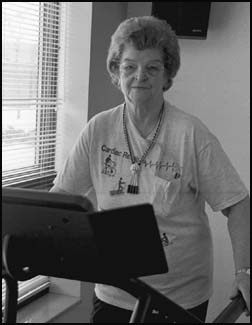 You donít need to tell Kathryn Buermann about the danger heart disease poses to women. For more than a year, she thought she suffered from heartburn, and treated it with over-the-counter pharmaceuticals.
You donít need to tell Kathryn Buermann about the danger heart disease poses to women. For more than a year, she thought she suffered from heartburn, and treated it with over-the-counter pharmaceuticals. In October, she quickly realized something more serious was wrong.
On Oct. 19 at 1 a.m., unbearable pain shot through her arms. ďI cried all the way to the hospital when the boys took me in, it hurt so bad,Ē she recalled. She was given a nitroglycerine tablet under her tongue to ease her pain by relaxing her blood vessels and allowing blood to flow. She was also put on a heart monitor.
When the pain returned the next night, they sent her straight to St. Cloud by ambulance for an angiogram and more tests.
They discovered her clogged arteries before she had a heart attack. Several were over 90 percent blocked. There was an option for treating her condition with medication. ďNo way,Ē she said. She did not want the pain to return and felt surgery was a more permanent cure. She was referred to the University of Minnesota, and she had triple by-pass surgery on Oct. 27.
After that she learned the truth about her heartburn. ďThe doctors say that was no gas problem,Ē she explained. ďThat was the start of my heart problem.Ē
The theme for American Heart Month this February is women and their risk of heart disease. The American Heart Association wants women to ďTake ChargeĒ and learn about the warning signs and risk factors for heart disease.
It is a myth that heart disease is only a problem for men and that women are immune or should be more concerned about other health problems. Heart disease is the leading killer of American women. Deaths of women due to cardiovascular diseases have risen every year since 1984, and 50,000 more women than men died from heart diseases in 1995.
While it is true that men typically encounter heart disease earlier than women and that women do enjoy some natural protection until menopause, at older ages women face serious health risks. Women are more likely to die suddenly as a result of heart attacks, often without any warning.
Strokes are the third leading cause of death for women, behind heart disease and cancer. Together, all cardiovascular diseases claim twice as many lives each year as cancer.
Kathryn worried about heart attacks, but not for herself. Her husband, Norbert, died from a massive heart attack at 67. His father died from a heart attack at 63 and his brother at 64. So with this history on her husbandís side of the family she worried for her sons. ďI wasnít worried about myself,Ē she said.
A risk factor for Kathryn, now 69, was her diabetes. Laura Odell, a pharmD at Paynesville Area Health Care System, said people with diabetes are two to four times as likely to die of heart disease. The exact cause of this risk is not known and is still being researched.
Odell said that heart disease and Type II diabetes have similar causes: high blood-pressure, high cholesterol, and obesity. ďWhen you put it all together,Ē she said, ďyou are sort of a heart attack waiting to happen.Ē
Controlling your blood sugar properly through diet is very important to minimize these causes.
Kathryn is now on the road to recovery. ďThey said I should be good for another 25 years,Ē she said. She takes aspirin every day to thin her blood and is on a no fat, no sugar, and no salt diet.
Soon after surgery, her rehabilitation began. ďYou didnít stay in bed too long. They got you up right away,Ē she explained.
After leaving the hospital, she couldnít drive for six weeks, and at first she held a chest pillow against her heart while riding in the car or when she had to cough.
For the past three months, she has been doing her cardiac rehabilitation. Three times a week she works out for an hour at the Paynesville Area Health Care System. From Medicare, she received the maximum of 36 sessions of rehabilitation, which covers about 12 weeks. After that, the hospital provides an additional month free of charge.
The cardiac rehabilitation center at the hospital has helped 250 patients since 1989. In 1998, 36 people completed programs, and 14 were women.
Beth Person, a registered nurse, said the rehabilitation starts with education about heart disease, including reading material, videos, and discussion. Then patients attempt to regain their strength through exercise. One goal is for them to regain their independence.
At the center, a patientís heart is constantly monitored and a nurse is observing the exercise, so the exercise is done safely. Person said some patients have a lot of concern about what they can and canít do.
Their patients are typically older, but they have helped people as young as 16 and as old as 87. There are no age limits.
Most of the patients are recovering either from heart attacks or from by-pass surgery. Rehabilitation is generally covered by insurance, but there are some conditions that are not covered and rehabilitation is on a self-pay basis.
Cardiac rehabilitation is in the same room as the Wellness Workshop at the hospital. The public may use the equipment for a monthly fee: $20 per individual, $30 per couple, and $40 per family.
Kathryn feels she is in better shape now than before her surgery. She no longer has any trouble climbing the steep driveway to her house. Sheís even started back to work part time at Tuckís Cafe.